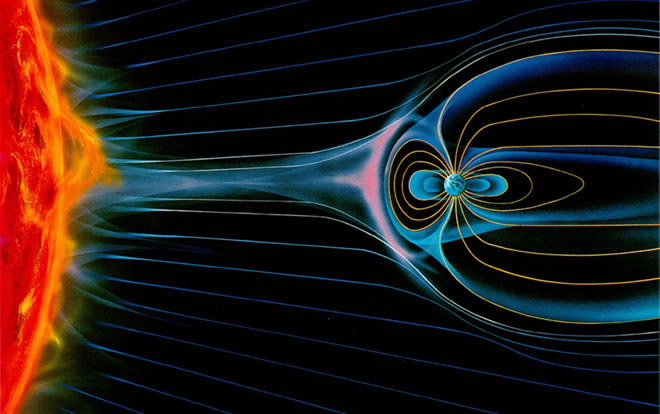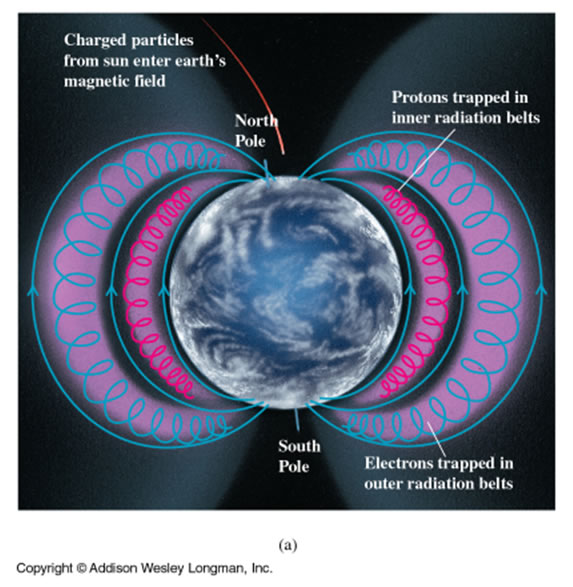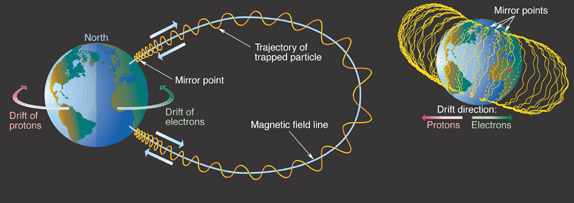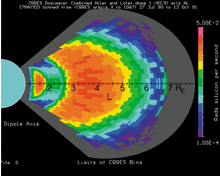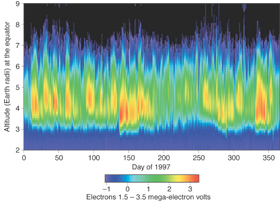RADIATION ENVIRONMENT
A summary of J.E. Mazur Article on Space Radiation from
The Aerospace Corporation and other related articles
http://www.aero.org/index.html
Article
http://www.aero.org/publications/crosslink/summer2003/02.html
Solar and cosmic radiation high-energy particles, belts of protons, electrons and
ions collected within Earth's magnetic field is a hazard to satellites and their
hardware.
The Apollo missions exposed the astronauts to this radiation because the lunar orbit
took them outside the earth's geomagnetic shield.
This radiation is relatively uncommon within Earth's atmosphere and therefore many
commercial off the shelve parts manufacture do not account for these sources in earth
designs. The regions that satellites encounter radiation areas include the Van Allen
belts, cosmic rays, neutrons, and other subatomic particles created in high-energy
collisions of primary particles with spacecraft materials. The space environment
also changes with time, often in unpredictable and undiscovered ways, making it a
challenge to completely assess the hazards in any orbit.
Typical satellite orbits cross many of these regions and spend a variable amounts
of time in each. The unit of kinetic energy for these particles is the electron volt.
At high energies (millions of electron volts), these particles have sufficient energy
to ionize atoms in materials through which they propagate. At lower energies
(below thousands of electron volts) their effects range from charge accumulation on
surfaces to material degradation. The interaction of space particles with spacecraft
materials and electronics is complex to describe and difficult to simulate with
ground-based test facilities.
Interplanetary Space and Galactic Cosmic Rays
The sun and most planets in the solar system generate magnetic fields and these contain
its own population of particles and radiation. Several satellites near Earth
continuously monitor the intensity of the particles and electromagnetic fields in
interplanetary space. Space satellites that monitor this radiation have determined
that the radiation is highly variable, but the consistent locations of intensities
occur in the planetary magnetospheres.
The space between the planets is not a vacuum, but at about 10 particles per cubic
centimeter, the particle density is many orders of magnitude below typical densities
of materials found on Earth. For radiation effects it is not only the particle density,
but also how the energy is distributed among the particles that determines their
hardness to space missions. Measurements have shown a tremendous range in both
particle intensity and energy, with fewer and fewer particles at higher and higher
energies.
Galactic cosmic rays have the highest-energy particles in the solar system.
They originate outside the solar system (possibly in supernova shocks) and probably
represent the accumulated output of many particle sources and acceleration processes.
Always Their considerations consist of about 87 percent protons, 12 percent helium
nuclei, and 1 percent heavier ions.
The sun is ejects disturbances into interplanetary space and as these disturbances
propagate, they carry tangled magnetic fields that scatter the lowest-energy
galactic particles. The galactic particle intensity at Earth varies inversely with
the solar cycle (it also varies with radial distance from the sun and latitude
above the ecliptic plane, although these effects are small compared to the solar
cycle variations).
Solar Wind amd Solar Energetic Particles
Most of the particles in interplanetary space are in the form of a hot, ionized gas
called the solar wind. It is ejected radially from the sun with a speed at Earth that
varies from about 300 to 1000 kilometers per second. This represents a mass loss of
about 1014 kilograms per day. X-ray images of the solar atmosphere at low altitudes
show regions of varying intensity and therefore varying particle winds. The brightest
and hottest regions, with temperatures at several million degrees, lie above sunspots.
The darker areas are coronal holes large, cooler volumes of the atmosphere filled with
magnetic field lines that extend into interplanetary space. In the coronal holes,
the solar wind travels about twice as fast as it does from regions on the sun with
magnetic fields that loop back to the surface.
Explosive ejections of large volumes of the solar atmosphere, known as coronal mass
ejections, draw out complex loops of magnetic field into interplanetary space. The
magnetic field's direction and strength determine how energy from the solar wind gets
transferred into the planetary magnetospheres. Many highly variable sources produce
interplanetary particles with energies typically between 10 thousand and 100 million
electron volts.
While these energy releases are generally called "proton events." Protons are the most
abundant ions produced, these events also energize ions as heavy as iron. Both the
protons and the heavy ions are hazardous to spacecraft: The more abundant protons are
primarily responsible for anomalies resulting from the total radiation dose, while
heavy ions contribute most to anomalies known as single-event effects.
Earth's Magnetosphere and the Van Allen Belts
Earth's magnetic field establishes a volume of space within which the magnetic field
dominates charged particle motion. Close to Earth, the magnetic field is roughly a
magnetic dipole that is tilted 11.5 degrees from the rotational axis andfor most
purposes, the dipole approximation is poor.
The magnetosphere is complex and dynamic because of its interaction with the variable
solar wind and transient phenomena from the sun. The sunward dimension can change by
more than a factor of two depending on the interplanetary magnetic field and solar wind
upstream from Earth. The magnetosphere contains a mixture of plasmas with incredibly
diverse sources. The magnetosphere has its own weather, with complex processes of
particle transport and acceleration during geomagnetic storms that contribute to
surface charging and internal charging of spacecraft.
A charged particle in a constant magnetic field experiences a force perpendicular to
its motion. The resulting trajectories of ions and electrons in the magnetosphere are
a complex superposition of motions as each particle travels in a spiral around a
magnetic field line, bounces back and forth between the North and South Poles, and
drifts around the planet, with electrons drifting east and protons drifting west.
As these particles are trapped on time scales ranging from days to years, they execute
their gyration, bounce, and drift motions around Earth, resulting in spatial zones of
trapped radiation known as the Van Allen belts. The inner zone is the proton belt
(peak intensity at about 3000 kilometers from Earth's surface) and the outer zone the
electron belt (peak intensity from about 12,000 to 22,000 kilometers from the surface).
There are trapped electrons and protons throughout the magnetosphere. Also, the
particles that contribute most to the radiation dose in the inner zone are protons
and those contributing most in the outer zone are electrons. Occasionally, new radiation
belts form between the inner and outer zones when interplanetary shock waves from
coronal mass ejections hit the magnetosphere. The inner zone is the relative stability
zon which results from a combination of long particle lifetimes in this part of the
magnetic field and the slowly varying cosmic ray input.
All spacecraft in low Earth orbit penetrate the inner zone in the South Atlantic Anomaly
even if their altitude is below the belt at other positions in the orbit. While relative
stability is one key property of the inner zone, variability is the outstanding
characteristic of the outer radiation belt. This is important because as seen in
Figure E5 depending on the orbit of a satleite will determine how much and what kind
of radiation a satellite will see.
Examples of Current Research and Plasma Effects on Surfaces of satellites
Several factors continually press the need for a better specification and understanding
of the space environment. One is the increase in spacecraft lifetimes, leading to
questions about longer-term exposures than have been tested in the past. Another is the
growing interest in uncommon orbits, where the residence time in different hazard areas
is unlike what has been experienced. A third is the use of new materials, which need to
be assessed for suitability in space. Aerospace has been conducting research to address
the concerns raised by these and other issues. This will become more important factor
as the need for satellite lifetimes to increase to keep them profitable longer.
Space plasmas can change the physical properties of exposed surfaces. For example,
optical coatings are used to increase the efficiency of solar arrays; their performance
depends in part on their transmittance, which can change after a long exposure to the
space plasma environment. Aerospace is beginning to derive preliminary specifications
of the low-energy plasmas around Earth based on data from previous and active science
missions.
Extreme Value Analysis
The highest intensity of outer-belt electrons in the past 16 years occurred in a
geomagnetic storm on March 28, 1991. One question important for space systems design
is whether a similar or more intense event will occur during a future mission.
Aerospace has used mathematical tools such as statistics of extreme events to help
answer this question. The analysis indicates that the March 1991 event was equivalent
to a 20-year storm. The analysis also suggests that a 100-year storm could be about
twice as intense. This mathematical approach does not predict when such events will
occur, but it has potential to specify the extreme environment, thereby satisfying
an important engineering requirement.
Acknowledgements
The author of the primary source would like to thank P. C. Anderson, J. B. Blake,
M. W. Chen, J. F. Fennell, H. C. Koons, M. D. Looper, T. P. O'Brien, J. L. Roeder,
R. S. Selesnick, also thanks to the Aerospace Coreperation for sharing their indepth
knowledge of space radiation enviroments.
The Aerospace Corporation
Headquartered in El Segundo, California
The Aerospace Corporation has provided independent technical and scientific research,
development, and advisory services to national-security space programs since 1960.
They operate a federally funded research and development center (FFRDC) for the
United States Air Force and the National Reconnaissance Office and support all
national-security space programs. They also apply more than 40 years of experience
with space systems to projects for civil agencies like NASA and the National Oceanic
and Atmospheric Administration, commercial companies, universities, and some
international organizations in the national interest.
